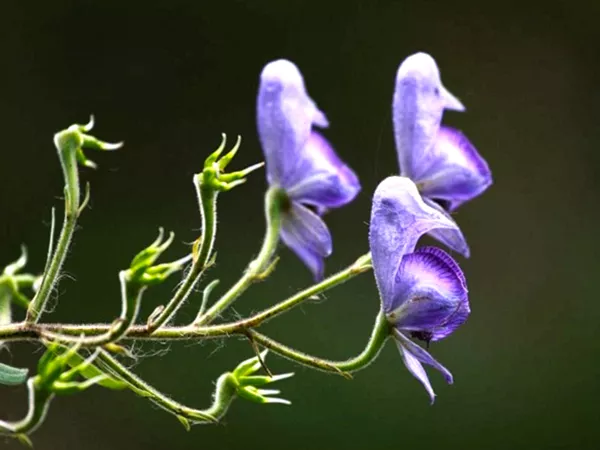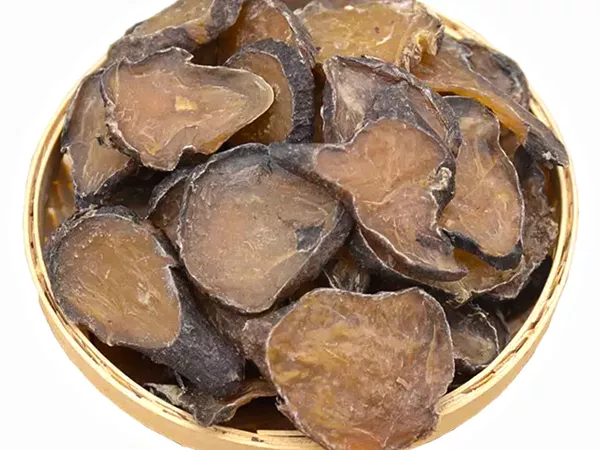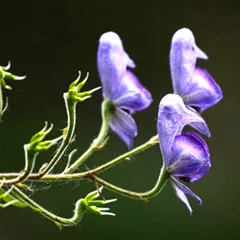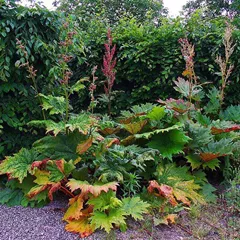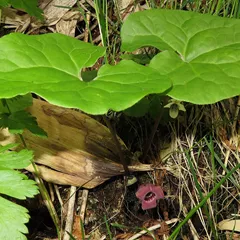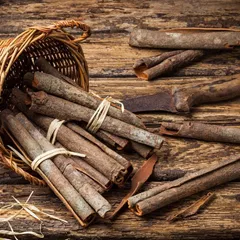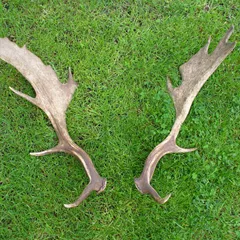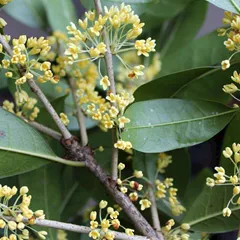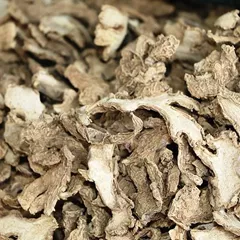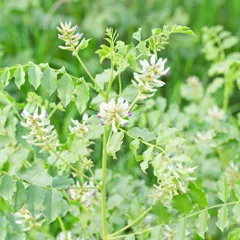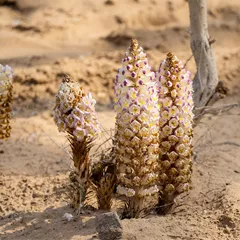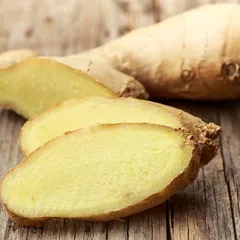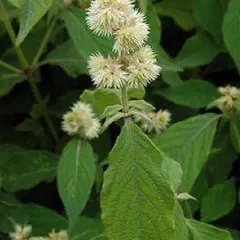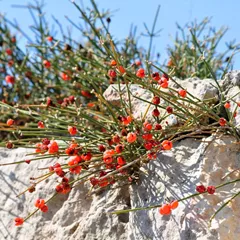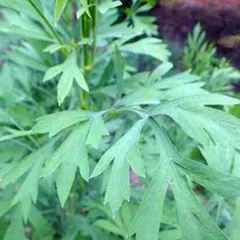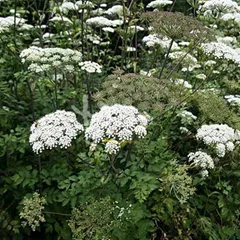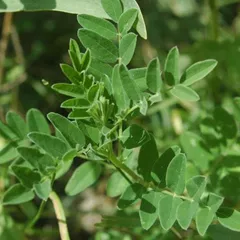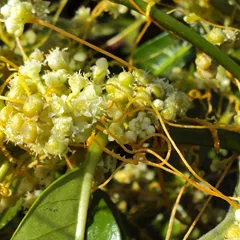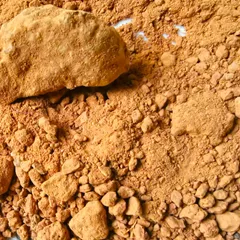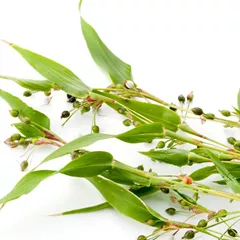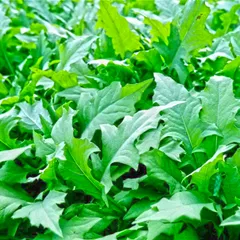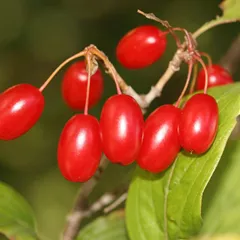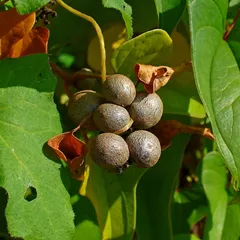Zhi Fu Zi
Zhi Fu Zi
English: Prepared aconite
Chinese: 制附子
Use of Zhi Fu Zi (prepared aconite) in TCM
Please note that you should never self-prescribe TCM ingredients. A TCM ingredient is almost never eaten on its own but as part of a formula containing several ingredients that act together. Please consult a professional TCM practitioner, they will be best able to guide you.
Preparation: There are various methods of preparing this herb to neutralize its toxicity. In one method it is treated with salt and then boiled with Licorice and black soya beans. In any case it absolutely needs to be boiled for at least 1 hour in order to reduce its toxicity.
Dosage: 3 - 9 grams
Main actions according to TCM*: Raises the collapse of Yang. Warms the meridians and relieves pain caused by Cold. Reduces Damp caused by Deficiency in Yang.
Primary conditions or symptoms for which Zhi Fu Zi may be prescribed by TCM doctors*: Weak pulse Fatigue Impotence Arthralgia Vomiting Diarrhea Numbness of limbs
Contraindications*: Should not be used by those with Yin Deficiency, with true Heat, with false chills or during pregnancy. This is a toxic herb so it shouldn't be taken in large doses and it needs to be prepared adequately by a TCM professional before ingestion.
Common TCM formulas in which Zhi Fu Zi is used*
Da Huang Fu Zi Tang
Source date: 220 AD
Number of ingredients: 3 herbs
Formula key actions: Warms the Interior. Disperses Cold. Unblocks the bowels. Alleviates pain.
Conditions targeted*: Trigeminal neuralgiaPeriarthritis of the shoulder and others
Zhi Fu Zi is a king ingredient in Da Huang Fu Zi Tang. Like the name indicates, it means it has more power than other ingredients in the formula.
In Da Huang Fu Zi Tang, Zhi Fu Zi is the most effective substance in the Materia Medica for warming the Yang and dispelling Cold. In this case, because the Cold is severe and it is combined with a cooling substance, Rhubarb (Da Huang)'s dosage is higher than usual.
Zhen Wu Tang
Source date: 220 AD
Number of ingredients: 5 herbs
Formula key actions: Warms and tonifies the Yang and Qi of the Spleen and Kidneys. Eliminates Dampness.
Conditions targeted*: Congestive heart failureChronic glomerulonephritis and others
Zhi Fu Zi is a king ingredient in Zhen Wu Tang. Like the name indicates, it means it has more power than other ingredients in the formula.
In Zhen Wu Tang, Zhi Fu Zi tonifies the Fire at the Gate of Vitality, restores the Kidney Yang, and thereby enables the Kidneys to resume their function of transforming water.
Fu Zi Tang
Source date: 220 AD
Number of ingredients: 5 herbs
Formula key actions: Warms the Meridians. Assists the Yang. Dispels Cold. Transforms Dampness.
Conditions targeted*: MigraineCluster headache and others
Zhi Fu Zi is a king ingredient in Fu Zi Tang. Like the name indicates, it means it has more power than other ingredients in the formula.
In Fu Zi Tang, Zhi Fu Zi penetrates into the Gate of Vitality to invigorate the Yang and disperses Cold from all twelve Meridians.
As noted by Zhang Jie-Bin, a famous Chinese medicine doctor: "[Prepared aconite (Zhi Fu Zi)] is an essential herb for Yin-type patterns. In all cases of Cold damage that transmit or transform into [disorders of one of] the three Yin [warps] as well as in [direct] Cold strike into the Yin [warps], if the pulse is submerged, it must be used even if there is high fever."
You Gui Wan
Source date: 1624 AD
Number of ingredients: 10 herbs
Formula key actions: Warms and tonifies Kidney Yang. Replenishes the Essence. Tonifies the Blood.
Conditions targeted*: Nephrotic syndromeOsteoporosis and others
Zhi Fu Zi is a king ingredient in You Gui Wan. Like the name indicates, it means it has more power than other ingredients in the formula.
In You Gui Wan, Zhi Fu Zi works together with Cinnamon bark (Rou Gui) and Deer antlers glue (Lu Jiao Jiao) to warm and fortify the source Yang.
Shen Qi Wan
Source date: 220 AD
Number of ingredients: 8 herbs
Formula key actions: Tonifies and warms Kidney Yang.
Conditions targeted*: Diabetes mellitusHyperaldosteronism and others
Zhi Fu Zi is a king ingredient in Shen Qi Wan. Like the name indicates, it means it has more power than other ingredients in the formula.
In Shen Qi Wan, Zhi Fu Zi is acrid and strongly warming. It tonifies the Fire of Gate, dispels Cold, and eliminates Dampness. It also strongly promotes movement and reaches down to the source to warm chronic Cold. Together, Zhi Fu Zi and Cinnamon twigs not only assist the Yang and enhance the metabolism of water, but also promote the unhindered dispersion of Yang throughout the body. The relatively small dosage of these ingredients suggests that they are intended only to slightly generate Yang in order to strengthen the Kidney Qi.
Si Ni Tang
Source date: 220 AD
Number of ingredients: 3 herbs
Formula key actions: Rescues devastated Yang. Warms the Middle Burner. Stops diarrhea.
Conditions targeted*: Acute cardiac insufficiencyCerebrovascular insufficiency and others
Zhi Fu Zi is a king ingredient in Si Ni Tang. Like the name indicates, it means it has more power than other ingredients in the formula.
In Si Ni Tang, Zhi Fu Zi breaks through the Yin and revives the Yang. It is especially effective in warming and stimulating the Fire at the Gate of Vitality so that it disseminates throughout the body and reaches the extremities.
Wen Pi Tang
Source date: 650 AD
Number of ingredients: 5 herbs
Formula key actions: Warms and tonifies the Spleen Yang. Clears Cold Evil.
Conditions targeted*: Ulcerative colitisChronic bacillary dysentery and others
Zhi Fu Zi is a king ingredient in Wen Pi Tang. Like the name indicates, it means it has more power than other ingredients in the formula.
In Wen Pi Tang, Zhi Fu Zi is acrid and strongly warming. It disperses the congealed Cold, by stimulating the Yang of the Spleen.
Zan Yu Dan
Source date: 1624 AD
Number of ingredients: 14 herbs
Formula key actions: Warms and tonifies the Kidneys.
Conditions targeted*: Erectile dysfunctionInfertility in male and others
Zhi Fu Zi is a king ingredient in Zan Yu Dan. Like the name indicates, it means it has more power than other ingredients in the formula.
In Zan Yu Dan, Zhi Fu Zi tonify the Kidneys and strengthen the Kidney Yang.
Bai Zhu Fu Zi Tang
Source date: 220 AD
Number of ingredients: 5 herbs
Formula key actions: Warms the channels. Disperses Cold. Strenghtens the Middle Burner. Promotes the resolution of Dampness .
Conditions targeted*: Degenerative joint diseasePost-stroke debility and others
Zhi Fu Zi is a king ingredient in Bai Zhu Fu Zi Tang. Like the name indicates, it means it has more power than other ingredients in the formula.
In Bai Zhu Fu Zi Tang, Zhi Fu Zi has the strong nature of warming and dispersing, so that it mobilizes the Yang Qi at the gate of vitality to spread throughout the entire body to reach the Exterior, the Middle Burner, and the Intestines.
Hui Yang Jiu Ji Tang
Source date: 1445 AD
Number of ingredients: 11 herbs
Formula key actions: Restores and revives the Yang. Augments the Qi. Revives the pulse.
Conditions targeted*: Myocardial infarctionCardiogenic shock and others
Zhi Fu Zi is a king ingredient in Hui Yang Jiu Ji Tang. Like the name indicates, it means it has more power than other ingredients in the formula.
In Hui Yang Jiu Ji Tang, Zhi Fu Zi is hot and strong. It is able to restore and revive the Yang, stem rebelliousness, augment the Qi and generate the pulse.
It is used in the situation that the Yang is exhausted and Cold invades all three Yin warps.
Ji Sheng Shen Qi Wan
Source date: 1695 AD
Number of ingredients: 10 herbs
Formula key actions: Tonifies and warms Kidney Yang.
Conditions targeted*: EdemaHeavy back and others
Zhi Fu Zi is a king ingredient in Ji Sheng Shen Qi Wan. Like the name indicates, it means it has more power than other ingredients in the formula.
In Ji Sheng Shen Qi Wan, Zhi Fu Zi is acrid and strongly warming. It tonifies the Fire of Gate, dispels Cold, and eliminates Dampness.
It also strongly promotes movement and reaches down to the source to warm chronic Cold. Together, Zhi Fu Zi and Rou Gui not only assist the Yang and enhance the metabolism of water, but also promote the unhindered dispersion of Yang throughout the body.
Gui Zhi Shao Yao Zhi Mu Tang
Source date: 220 AD
Number of ingredients: 9 herbs
Formula key actions: Clears Heat and inflammations. Unblocks the flow of Yang Qi and promotes movement (in areas with painful obstruction). Clears Wind and Damp. Relieves pain.
Conditions targeted*: Rheumatoid arthritisConnective tissue disorders and others
Zhi Fu Zi is a deputy ingredient in Gui Zhi Shao Yao Zhi Mu Tang. This means it helps the king ingredient(s) treat the main pattern or it serves to treat a coexisting pattern.
In Gui Zhi Shao Yao Zhi Mu Tang, Zhi Fu Zi warms the Channels and relieves pain.
Shen Fu Tang
Source date: 1445 AD
Number of ingredients: 2 herbs
Formula key actions: Restores Yang. Strongly tonifies the source Qi. Saves Qi from collapsing due to devastated Yang.
Conditions targeted*: Cardiac failureMyocardial infarction and others
Zhi Fu Zi is a deputy ingredient in Shen Fu Tang. This means it helps the king ingredient(s) treat the main pattern or it serves to treat a coexisting pattern.
In Shen Fu Tang, Zhi Fu Zi It is warm and it strengthens the true Yang at the Gate of Vitality (Ming Men).
Together with Ginseng, it assists the Spleen which is responsible for
food and Body Fluids' transformation to Qi. It also support Qi circulating.
Da Fang Feng Tang
Source date: 1107 AD
Number of ingredients: 14 herbs
Formula key actions: Expel Wind Damp. Relieve pain. Tonify the Liver and the Kidneys. Tonify the Blood and Qi.
Conditions targeted*: ArthralgiaCommon cold and others
Zhi Fu Zi is a deputy ingredient in Da Fang Feng Tang. This means it helps the king ingredient(s) treat the main pattern or it serves to treat a coexisting pattern.
In Da Fang Feng Tang, Zhi Fu Zi warms the Channels and supports the Yang. It also helps relieve obstruction pain in the joints by expelling Damp Cold.
Ma Huang Xi Xin Fu Zi Tang
Source date: 220 AD
Number of ingredients: 3 herbs
Formula key actions: Tonifes the Yang. Releases the Exterior.
Conditions targeted*: Common coldBronchial asthma and others
Zhi Fu Zi is a deputy ingredient in Ma Huang Xi Xin Fu Zi Tang. This means it helps the king ingredient(s) treat the main pattern or it serves to treat a coexisting pattern.
In Ma Huang Xi Xin Fu Zi Tang, Zhi Fu Zi acrid and warm. It warms the Kidneys and also boosts the Yang.
Ephedra and Prepared aconite is a good pair in this formula. Ephedra opens the skin pores to expels pathogen, while Prepared aconite boosts the Interior Yang Qi to push the pathogen.
Zai Zao San
Source date: 1445 AD
Number of ingredients: 12 herbs
Formula key actions: Tonfies the Yang . Augments the Qi. Induces sweating. Releases the Exterior.
Conditions targeted*: Rheumatic feverCommon cold and others
Zhi Fu Zi is a deputy ingredient in Zai Zao San. This means it helps the king ingredient(s) treat the main pattern or it serves to treat a coexisting pattern.
In Zai Zao San, Zhi Fu Zi releases the Exterior by dispersing Cold and activating the Yang along with Cinnamon twigs and Wild ginger.
Tu Si Zi Wan
Source date: 1253 AD
Number of ingredients: 11 herbs
Formula key actions: Warms the Kidneys. Prevents abnormal leakage such as urinary incontinence or seminal emissions.
Conditions targeted*: Urinary incontinenceSeminal emission and others
Zhi Fu Zi is a deputy ingredient in Tu Si Zi Wan. This means it helps the king ingredient(s) treat the main pattern or it serves to treat a coexisting pattern.
In Tu Si Zi Wan, Zhi Fu Zi warms the Kidney Yang.
Huang Tu Tang
Source date: 220 AD
Number of ingredients: 7 herbs
Formula key actions: Warms the Yang. Strengthens the Spleen. Nourishes the Blood. Stops bleeding.
Conditions targeted*: Chronic hemorrhagic gastritisPeptic ulcers and others
Zhi Fu Zi is a deputy ingredient in Huang Tu Tang. This means it helps the king ingredient(s) treat the main pattern or it serves to treat a coexisting pattern.
In Huang Tu Tang, Zhi Fu Zi warms the Yang and strengthens the Spleen, thereby restoring the ability of the Spleen and Stomach Qi to govern the Blood.
Therefore, this herb is able to stop bleeding due to Spleen Qi and Yang Deficiency.
It also counterbalances the cloying, greasy, Yin and Blood tonifying nature of the assistant herbs of the formula.
Yi Yi Fu Zi Bai Jiang San
Source date: 220 AD
Number of ingredients: 3 herbs
Formula key actions: Expels pus and reduces abscesses. Warms the Yang. Disperses clumping.
Conditions targeted*: Acute appendicitisChronic appendicitis and others
Zhi Fu Zi is an assistant ingredient in Yi Yi Fu Zi Bai Jiang San. This means that it either serves to reinforces the effect of other ingredients or it moderates their toxicity.
In Yi Yi Fu Zi Bai Jiang San, Zhi Fu Zi stimulates the Yang. It assists Job's tears in dispersing Damp-Cold and prevents the cooling nature of Patrinia from causing further harm to the body's Yang Qi, even as it accentuates its ability to disperse abscesses, open areas of constraint, and invigorate Qi and Blood in the Intestines.
Ba Wei Di Huang Wan
Source date: 220 AD
Number of ingredients: 8 herbs
Formula key actions: Tonifies Yang. Warms the Kidneys and lower extremities.
Conditions targeted*: Diabetes mellitusDiabetes insipidus and others
Key TCM concepts behind Zhi Fu Zi's properties
In Traditional Chinese Medicine (TCM), Zhi Fu Zi belongs to the 'Herbs that warm the Interior and/or expel Cold' category. Herbs in this category are used for Internal Cold with Qi Deficiency and/or Yang Deficiency. In the Yin and Yang system of thought Yang is Hot in nature. A deficiency of Yang will therefore lead to Internal Coldness since there will as a result be more Yin (Cold in nature) than Yang. In extreme cases this can lead to so-called 'Yang collapse' with convulsions or coma and these herbs are particularly indicated to treat such scenarios.
As suggested by its category Zhi Fu Zi is Hot in nature. This means that Zhi Fu Zi typically helps people who have too much "Cold" in their body. Balance between Yin and Yang is a key health concept in TCM. Those who have too much 'Cold' in their body are said to either have a Yin Excess (because Yin is Cold in nature) or a Yang Deficiency (Yang is Hot in Nature). Depending on your condition Zhi Fu Zi can help restore a harmonious balance between Yin and Yang.
Zhi Fu Zi also tastes Pungent and Sweet. The so-called 'Five Phases' theory in Chinese Medicine states that the taste of TCM ingredients is a key determinant of their action in the body. Pungent ingredients like Zhi Fu Zi tends to promote the circulations of Qi and Body Fluids. That's why for instance someone tends to sweat a lot when they eat spicy/pungent food. On the other hand Sweet ingredients tend to slow down acute reactions and detoxify the body. They also have a tonic effect because they replenish Qi and Blood.
The tastes of ingredients in TCM also determine what Organs and Meridians they target. As such Zhi Fu Zi is thought to target the Heart, the Kidney and the Spleen. In addition to regulating Blood flow, in TCM the Heart is believed to be the store of the 'Mind' which basically refers to someone's vitality. The Kidneys do not only regulate the urinary system but also play a key role in the reproductive system and the growth and aging process of the body. The Spleen assists with digestion, Blood coagulation and Fluids metabolism in the body.

